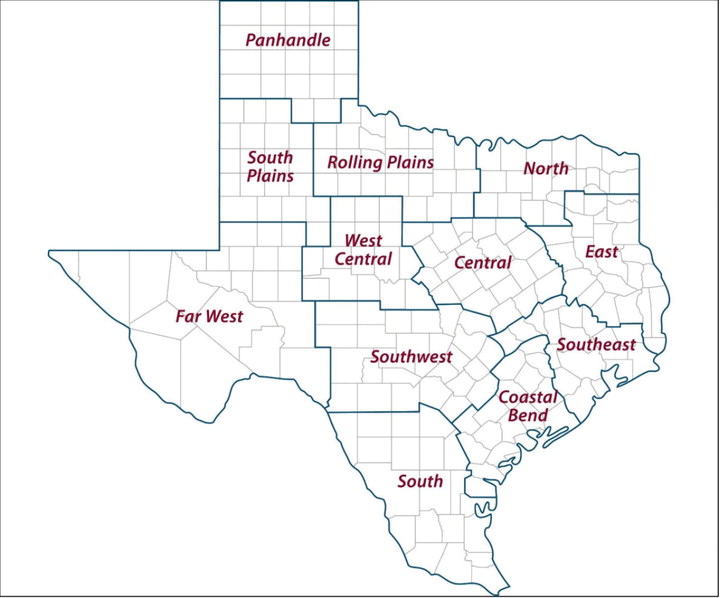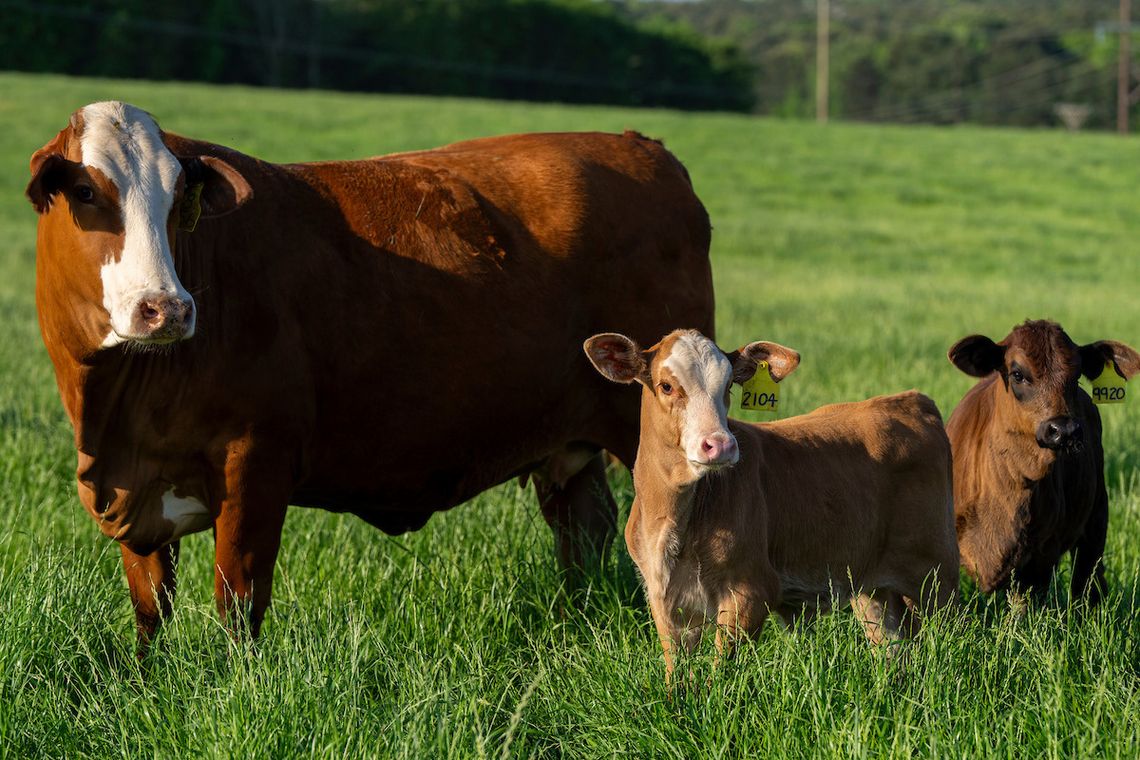Constrained cattle supplies and strong beef demand continue to fuel record prices at all levels of the U.S. beef market – from sale barns to grocery aisles, said Texas A&M AgriLife Extension Service experts.
Jason Cleere, Ph.D., AgriLife Extension statewide beef cattle specialist in the Texas A&M Department of Animal Science, Bryan-College Station, said cow/calf producers are realizing strong calf sale prices as a result of strong consumer demand for beef and low cattle supplies.
The national cattle herd continues to hover at historically low numbers following bouts of drought across major beef-producing states, including backto- back years of extreme drought across Texas.
The national beef herd hit a 73-year low in January 2024 at 28.2 million head. Beef herd numbers have increased slightly to 28.7 million head, according to the U.S. Department of Agriculture July cattle inventory report, but cowcalf prices continue to reach new heights.
Cleere said feeding cattle to heavier weights has helped make up for lower cattle numbers, but beef production is down yearover-year overall. Cleere said the herd size coupled with strong consumer demand at the retail level has continued to fuel historically high prices for cowcalf producers.
“Retail prices are high, but there is still strong consumer demand,” Cleere said. “On the other end of production, you have ranchers capitalizing on record calf prices and asking, ‘How long are these high calf prices going to last?’” Cow/calf biology weigh on U.S. beef market David Anderson, Ph.D., AgriLife Extension economist in the Texas A&M Department of Agricultural Economics, Bryan-College Station, said low herd numbers and fewer market- ready calves are fueling record high prices at all levels of the beef market.
“We’ve got record high calf prices and record high fed cattle prices, and that is fueling record high beef prices on the wholesale and retail side,” he said. “Beef supplies have been particularly low since April while the demand from meatpackers and ultimately consumers has been strong.”
Nationally, Anderson said 300-400-pound calves were averaging $4.67 per pound while 500-600pound calves were bringing $4.17 per pound on average. Localized sale prices have been even higher.
A weekly price-trend report by Jason Banta, Ph.D., AgriLife Extension beef cattle specialist, Overton, shows the average high price reported by six Central and East Texas auctions was $5.25 per pound for 300-400-pound calves and $4.70 per pound for 500-600-pound calves.
Anderson said the present market is also a good snapshot of how beef production cycle dynamics can influence supply and ultimately prices throughout the year.
Springtime is calving time for most cattle operations, he said. Those spring-born calves will go to auction in the fall. That influx of supply tends to create a price low point for the year whereas fall- and winter-born calves are hit-
see LOW HERD INVENTORY on page 7 ting the market through spring and summer.
“It’s the biology of when calves are born and how fast they grow,” he said. “A decent number to go by from birth to finishing weight is 18-20 months, and that cycle can ripple through the sale barns all the way to the grocery store.”
Margins improve for Texas ranchers The USDA Economic Research Service estimated the value of U.S. beef cattle and calf production at more than $83 billion in 2024. Record calf prices have been “tremendous” for Texas cattle producers who endured years of drought and high input costs, Anderson said.
Cleere said margins for cow/calf producers have improved as grazing around the state improved and input costs fell some.
Ranchers are holding back replacement heifers, but better margins continue to incentivize selling those future calf-producing cows at rates that do not signal broader growth of the Texas or U.S. herd.
Anderson said individual producers may be utilizing excellent grazing conditions to keep or buy heifers to capitalize in the future, but most are seeing profitability now and taking it.
Both Anderson and Cleere expect calf prices to continue trending upward in 2026. Their upward price trajectory could steepen if more producers begin holding back more heifers for future calf production.
“Holding back heifers would really reduce the supply of calves for sale, and that usually drives prices even higher,” Anderson said. “You can’t discount the effect of rain and the good grazing conditions, which can lead to higher prices too, especially at local levels. But even with all that good grass, the incentive to sell is strong with these record high prices.”
Ranchers should plan for best and worst With no signs of a herd rebuild, Cleere recommends cow/calf producers find efficiencies where they can optimize profitability while prices are high. Reproductive efficiency, nutrition and herd health practices, forage management and operational improvements that reduce long-term costs can all factor into increased productivity.
Preparing for best- and worst-case scenarios can give producers the ability to adjust their strategies, he said.
“It’s easy to make a profit right now,” he said.
“But that is going to change, and we know eventually times will get leaner.”
AgriLife Extension district reporters compiled the following summaries: Southwest While scattered showers brought some areas over 2 inches of rain, hot and mostly dry conditions caused an overall reduction in soil moisture. Hay, corn and milo harvest continued with below-average yields reported for corn and milo.
Pecans were advancing in nut development, with some pecan scab reported.
The hot, dry conditions were stressing pastures and turfgrass, causing an increase in fungal infections and insect pest pressure.
Rangelands were drying out. Livestock and wildlife remained in good condition. Coastal Bend
Hot, dry weather continued, and soil moisture was low. Corn and sorghum harvest were nearly complete. Cotton looks good overall, and harvest should begin soon. Rice harvest continued with fair to good yields. Hay harvest was ongoing, with decent yields despite the heat.
Some producers were just completing first cuttings due to earlier weather delays. Range and pasture conditions were declining.
Livestock remained in good condition, but ongoing dry conditions may soon require changes to herd management. Some mealybugs in hayfields and pastures were reported.
South
Extreme heat and wind greatly reduced environmental moisture, but creeks and rivers maintained water levels. Despite some producers reporting up to 0.5 inch of rain, topsoil and subsoil conditions remained very dry. Vegetable crops have slowed but were still producing. Soil was being prepped for strawberries.
Corn and grain sorghum harvest continued. Cotton defoliation has started in earlier-planted fields, and harvest was expected soon. Late-planted grains needed a few more weeks until harvest. The pecan crop looks good for now. Peanut crops were growing under irrigation. Hay producers continued to irrigate and roll up bales when possible. Increasing temperatures were expected to dry out pastures and caused declining conditions. Livestock were in good condition, and producers were providing minimal supplements. Feed prices remain high, and producers were expected to thin out herds as triple-digit temperatures approach. Wildlife were in good condition.
South Plains
Despite very dry conditions over the past two weeks, subsoil and topsoil moisture levels remained on the higher side. This moisture was expected to decline as higher temperatures move in next week.
Irrigation was running at full capacity, and more rain was needed to maintain and finish crops. Earlier summer rain resulted in heavy weed pressure, and producers continued to control with sprays. Early planted dryland cotton was blooming, and growth regulators were being applied. Cucumber planting was expected to finish soon, with other crops like sorghum, peanuts, blackeyed peas and corn progressing well. Hay was being cut, and livestock were in good condition.
Aphids and lygus bugs were being seen, and treatments were being applied.
East
Subsoil and topsoil conditions were adequate. Hay production continued despite slower growth and lower soil moisture. Pasture and rangeland conditions were good overall.
Livestock were in fair to good condition, and cattle markets remained strong.
Producers have reported some armyworms and Bermuda grass stem maggots.
Far West
Overall good growing conditions reported for this time of the year, however, seasonal temperatures warmed, reaching 100 or just below most days.
Western portions of the region reported a variety of impacts due to an abundance of rain, while the eastern portion was in desperate need of measurable precipitation. Most irrigated cotton was blooming, fields that were not will see reduced yields this season. Quite a few fields have yet to produce a square, and these fields will not make anything.
Pima and Upland cotton was coming along nicely, but had some pest pressure. Corn was finished and drying down. Some sorghum neared maturity while other fields were just headed out and beginning to bloom. Melon harvest continued and demand was good. Alfalfa looks good but rains were expected, which could ultimately negatively impact price and quality if alfalfa was rained on. Sudan grass was also affected by rain while in windrows. Pecans were loaded up at this time, overall seems to be an “on” year. Range conditions continued to require additional supplementation. West Central
Conditions were hot and mostly dry, with some daytime highs above 100 degrees. Soil conditions remained good overall. A lack of precipitation allowed some areas to sufficiently dry out, and flood damage assessments ramped up. Row crops were beginning to show signs of stress from heat and lack of moisture. Sorghum harvest started for fields planted early, and later-planted sorghum is maturing. Corn was being cut for silage, and cotton and sorghum looked good overall. The pecan crop was reported as very little to acceptable. Hay baling continued with higherthan-normal yields. Pasture and range conditions looked good overall. Livestock remained in good condition. Armyworms were present and required treatment in some instances. Southeast
The region reported hot and dry weather overall, with some areas seeing temperatures above 100 degrees. Soil moisture ranged from adequate to surplus. Rice and corn were progressing well, with most rice heading.
Cotton ranged from fair to good. Corn and sorghum harvest is expected soon, and hay baling continued with only a few delays.
Pasture and rangeland conditions were fair to excellent, and livestock conditions were good overall.
Some pest issues, such as armyworms and stem maggots, emerged in limited areas and prompted insecticide applications.
Panhandle The district received scattered showers, with overall soil moisture ranging from short to adequate. Timely moisture, coupled with a drop in heat, promoted good conditions to finish summer crops. Overall crop conditions were reported as fair to good. Pasture and range conditions ranged from good to excellent. Producers were watching for signs of insect pressure and continued to treat for weed issues. Rolling Plains
Heat gave way to cooler temperatures and some scattered rainfall, but not enough to ease overall dry conditions. Crops like sorghum performed surprisingly well despite earlier flooding. Corn yields were fair, although production acreage was declining due to development. Cotton ranged from good to excellent. Hay production has been strong, and livestock were in good condition.
North
The region experienced hot temperatures and limited rainfall, leading to short to adequate soil moisture conditions. Corn, peanuts, sorghum and soybeans were progressing and range from fair to good condition. Harvest was nearing for many crops. Healthy pastures and rangelands supported overall good livestock conditions. A few sorghum aphids were observed in Johnsongrass along roadsides and field edges.
Grasshoppers and nuisance flies were noted, but no disease or major insect issues exist.






















